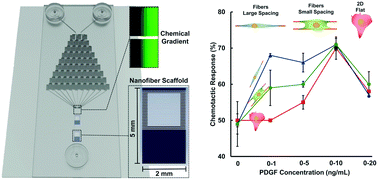Integrating nanofibers with biochemical gradients to investigate physiologically-relevant fibroblast chemotaxis†
Abstract
Persistent cell migration can occur due to anisotropy in the extracellular matrix (ECM), the gradient of a chemo-effector, or a combination of both. Through a variety of in vitro platforms, the contributions of either stimulus have been extensively studied, while the combined effect of both cues remains poorly described. Here, we report an integrative microfluidic chemotaxis assay device that enables the study of single cell chemotaxis on ECM-mimicking, aligned, and suspended nanofibers. Using this assay, we evaluated the effect of fiber spacing on the morphology and chemotaxis response of embryonic murine NIH/3T3 fibroblasts in the presence of temporally invariant, linear gradients of platelet-derived growth factor-BB (PDGF-BB). We found that the strength of PDGF-mediated chemotaxis response depends on not only the gradient slope but also the cell morphology. Low aspect ratio (3.4 ± 0.2) cells on flat substrata exhibited a chemotaxis response only at a PDGF-BB gradient of 0–10 ng mL−1. However, high aspect ratio (19.1 ± 0.7) spindle-shaped cells attached to individual fibers exhibited maximal chemotaxis response at a ten-fold shallower gradient of 0–1 ng mL−1, which was robustly maintained up to 0–10 ng mL−1. Quadrilateral-shaped cells of intermediate aspect ratio (13.6 ± 0.8) attached to two fibers exhibited a weaker response compared to the spindle-shaped cells, but still stronger compared to cells attached to 2D featureless substrata. Through pharmacological inhibition, we show that the mesenchymal chemotaxis pathway is conserved in cells on fibers. Altogether, our findings show that chemotaxis on ECM-mimicking fibers is modulated by fiber spacing-driven cell shape and can be significantly different from the behavior observed on flat 2D substrata. We envisage that this microfluidic platform will have wide applicability in understanding the combined role of ECM architecture and chemotaxis in physiological and pathological processes.



 Please wait while we load your content...
Please wait while we load your content...
